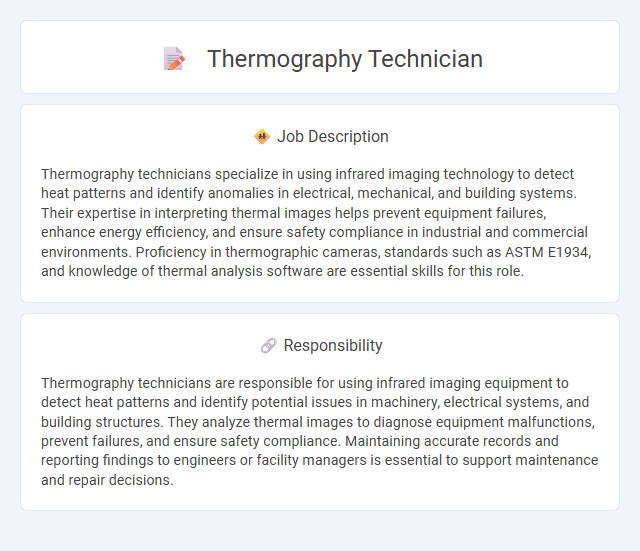
Thermography technicians specialize in using infrared imaging technology to detect heat patterns and identify anomalies in electrical, mechanical, and building systems. Their expertise in interpreting thermal images helps prevent equipment failures, enhance energy efficiency, and ensure safety compliance in industrial and commercial environments. Proficiency in thermographic cameras, standards such as ASTM E1934, and knowledge of thermal analysis software are essential skills for this role.
Individuals with keen attention to detail and strong analytical skills are likely suitable for a thermography technician role, as it involves interpreting thermal images to detect equipment or structural issues. Those comfortable working with technology and in environments that may include industrial sites or construction areas will probably find this job fitting. People who prefer repetitive tasks or have difficulty adapting to variable work settings might be less suited for this career path.
Qualification
Thermography technicians must possess certification from recognized bodies such as the Infrared Training Center (ITC) or the American Society for Nondestructive Testing (ASNT) to demonstrate proficiency in thermal imaging techniques. A strong background in electrical, mechanical, or industrial engineering enhances their ability to analyze infrared data accurately and troubleshoot equipment. Practical experience with thermal imaging cameras, along with knowledge of industry standards like ASTM E1934, is essential for ensuring reliable inspection results.
Responsibility
Thermography technicians are responsible for using infrared imaging equipment to detect heat patterns and identify potential issues in machinery, electrical systems, and building structures. They analyze thermal images to diagnose equipment malfunctions, prevent failures, and ensure safety compliance. Maintaining accurate records and reporting findings to engineers or facility managers is essential to support maintenance and repair decisions.
Benefit
Thermography technicians likely experience significant benefits such as enhanced career opportunities due to the high demand for energy efficiency assessments and predictive maintenance. The role probably offers a competitive salary and job stability as industries increasingly rely on thermal imaging technology for safety and quality control. Additionally, thermography technicians may find job satisfaction in contributing to environmental sustainability and reducing operational costs for businesses.
Challenge
Thermography technician roles likely involve complex challenges in accurately interpreting thermal images to detect equipment faults or building inefficiencies. The probability of encountering variable environmental conditions may require strong problem-solving skills and adaptability. Navigating the demand for precise thermal data analysis suggests continuous learning and technical expertise are often essential.
Career Advancement
Thermography technicians specialize in using infrared imaging technology to detect heat patterns and diagnose equipment issues, playing a crucial role in preventive maintenance across industries like manufacturing and building inspection. Career advancement opportunities include gaining certifications such as Level II or III infrared thermographer credentials, which enhance technical expertise and eligibility for higher-responsibility roles. Experienced thermography technicians can progress to supervisory positions, quality assurance, or become technical trainers and consultants within industrial maintenance and energy auditing sectors.
 kuljobs.com
kuljobs.com